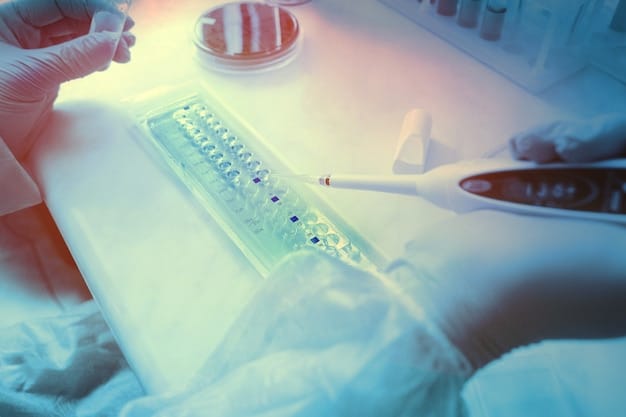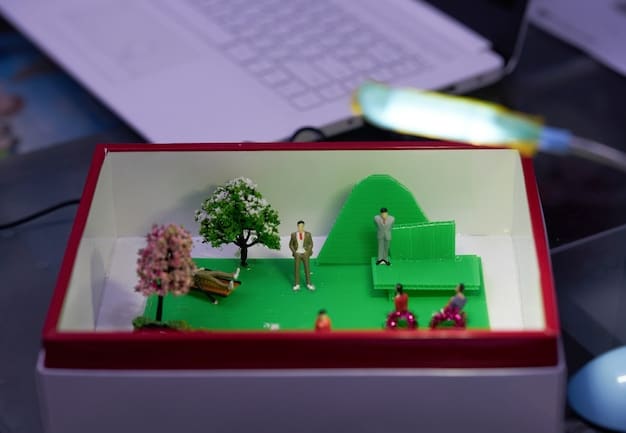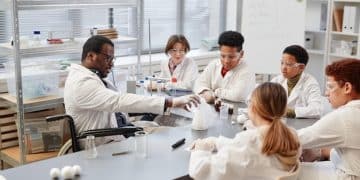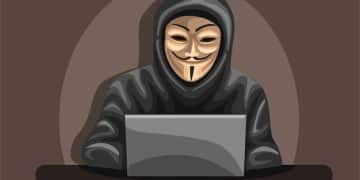DIY Biohacking: Redefining US Underground Culture & Ethics

DIY biohacking is revolutionizing US underground culture by enabling individuals to experiment with biology outside traditional labs, raising significant ethical considerations and offering practical implications for health and society.
The rise of DIY biohacking is creating a fascinating subculture within the US. Individuals are increasingly engaging in biological experimentation outside traditional academic and corporate settings. This trend is reshaping understandings of health, ethics, and the boundaries of scientific inquiry.
The DIY Biohacking Movement: A New Underground
The DIY biohacking movement, also known as citizen science or garage biology, is fueled by the desire to democratize scientific research. It allows individuals without formal scientific training to explore biology, genetics, and medicine through self-experimentation and community-based projects.
Origins of DIY Biohacking
This movement has roots in open-source software and the maker culture, emphasizing accessibility and collaboration. Early biohackers sought to break down the barriers to scientific knowledge and tools.
Driving Forces Behind the Movement
- Democratization of Science: Lowering the entry barriers and making scientific exploration accessible to everyone.
- Dissatisfaction with Traditional Research: Frustration with the slow pace and bureaucratic nature of academic and corporate research.
- Empowerment and Self-Improvement: Using biological tools to enhance personal health and well-being.
DIY biohacking is driven by a desire for empowerment, innovation, and a belief in open access to scientific knowledge. The movement challenges traditional scientific institutions and fosters a culture of experimentation and collaboration.

Ethical Boundaries: Where Do We Draw the Line?
One of the most significant aspects of the DIY biohacking movement is the ethical considerations it raises. When individuals experiment with biology outside regulated environments, the potential for harm increases.
Informed Consent and Safety
A key ethical concern is ensuring participants in DIY biohacking projects are fully informed about the risks and benefits involved. Self-experimentation can have unpredictable consequences.
Potential Risks and Mitigation Strategies
DIY biohacking projects can include risks such as the accidental creation of harmful organisms or the misuse of genetic information. Adhering to safety protocols and ethical guidelines is critical.
- Transparency and Open Communication: Sharing experimental protocols and results openly to foster peer review and collaboration.
- Risk Assessment: Conducting thorough risk assessments before starting any project to identify potential hazards and mitigation strategies.
- Community Oversight: Establishing community review boards to provide ethical guidance and oversight for DIY biohacking projects.
Ethical considerations are paramount in the DIY biohacking movement. Transparency, informed consent, and adherence to safety protocols are essential for mitigating risks and ensuring responsible experimentation.
Practical Implications for Health and Society
Despite the ethical concerns, DIY biohacking offers numerous potential benefits for health and society. The movement has the potential to accelerate scientific discovery and address unmet medical needs.
Examples of DIY Biohacking Projects
From developing low-cost medical diagnostics to creating novel therapies, DIY biohackers are pushing the boundaries of what is possible in healthcare.

Transformative Potential
DIY biohacking has the potential to revolutionize healthcare by empowering individuals to take control of their health. It could lead to more personalized treatments and innovative solutions to global health challenges.
Democratizing Healthcare
By making scientific tools and knowledge more accessible, DIY biohacking can help democratize healthcare, addressing inequalities and empowering underserved communities.
DIY biohacking has the potential to revolutionize healthcare by empowering individuals to take control of their health and fostering innovation. The democratization of scientific knowledge and tools can address inequalities and lead to more personalized treatments.
The Role of Technology in DIY Biohacking
Technology plays a crucial role in enabling and advancing the DIY biohacking movement. Accessible tools and platforms have made it easier for individuals to conduct experiments and share their findings.
Open-Source Hardware and Software
The availability of open-source hardware, such as 3D-printed lab equipment, and open-source software, like bioinformatics tools, has lowered the barrier to entry for DIY biohackers.
Online Communities and Collaboration Platforms
Online communities and collaboration platforms facilitate the sharing of knowledge, protocols, and data among DIY biohackers. This collaborative environment accelerates innovation and knowledge sharing.
- Advancements in Biotechnology: Easier access to gene editing technologies like CRISPR has enabled more sophisticated experiments.
- Crowdfunding and Citizen Science Platforms: These platforms allow DIY biohackers to raise funds and engage the public in their projects.
Technology is a driving force behind the DIY biohacking movement, providing access to tools, platforms, and communities that facilitate experimentation and collaboration. Open-source resources and online platforms have lowered the barrier to entry, enabling individuals to push the boundaries of scientific discovery.
Legal and Regulatory Landscape in the US
The legal and regulatory landscape surrounding DIY biohacking in the US is still evolving. While there are no specific laws targeting DIY biohacking, existing regulations related to biotechnology, pharmaceuticals, and medical devices may apply.
Current Regulations and Guidelines
Federal and state agencies, such as the FDA and the EPA, have the authority to regulate certain aspects of DIY biohacking, particularly those involving human subjects or the release of genetically modified organisms.
Challenges and Uncertainties
The lack of clear regulatory frameworks creates uncertainty for DIY biohackers and challenges for regulators. Striking a balance between fostering innovation and ensuring safety is critical.
- Need for Clear Guidance: Developing clear guidelines and regulations that address the unique challenges and opportunities presented by DIY biohacking.
- Collaboration Between Stakeholders: Engaging DIY biohackers, regulators, and other stakeholders in a dialogue to develop appropriate policies.
The legal and regulatory landscape surrounding DIY biohacking in the US is evolving. Clear guidance and collaboration between stakeholders are needed to foster innovation while ensuring safety and responsible experimentation.
Future Trends and Predictions
The DIY biohacking movement is poised for continued growth and evolution. Several trends are likely to shape the future of this subculture.
Increased Accessibility and Affordability
As technology continues to advance and become more affordable, DIY biohacking will become even more accessible to individuals and communities around the world.
Greater Emphasis on Ethical Considerations
As DIY biohacking becomes more mainstream, there will be a greater emphasis on ethical considerations and responsible experimentation. Community-led initiatives and self-regulation will play an increasingly important role.
- Integration with Traditional Science: Increased collaboration between DIY biohackers and traditional scientists may lead to breakthroughs and new approaches to research.
- Growth of Citizen Science Initiatives: Citizen science initiatives will expand, empowering individuals to contribute to scientific research and address pressing societal challenges.
The DIY biohacking movement is expected to grow, driven by increased accessibility, affordability, and a greater emphasis on ethical considerations. Collaboration with traditional science and the growth of citizen science initiatives will further shape the future of this subculture.
| Key Aspect | Brief Description |
|---|---|
| 🧪 Democratization | Opening science to the public, bypassing traditional institutions. |
| 🤝 Ethics | Involves navigating moral considerations in unregulated experiments. |
| 🧬 Potential | Offers personalized medicine and rapid problem-solving in health. |
| ⚖️ Regulation | Navigating existing laws for biotech, pharmaceuticals, and devices. |
FAQ
▼
DIY biohacking, also known as citizen science or garage biology, involves individuals conducting biological experiments outside traditional, regulated environments like universities or corporate labs.
▼
Ethical concerns include ensuring informed consent, managing risks involved in self-experimentation, and preventing the accidental creation or misuse of harmful organisms or genetic information outside of regulatory frameworks.
▼
Practical implications include developing low-cost medical diagnostics, creating novel therapies, accelerating scientific discovery, democratizing healthcare, and empowering individuals to take control of their health.
▼
Technology advancements such as open-source hardware (3D-printed lab equipment), software (bioinformatics tools), and online collaboration platforms lower barriers, making biohacking more accessible and enabling the rapid sharing of knowledge.
▼
The US regulatory landscape is still evolving, lacking specific laws for DIY biohacking. Existing regulations from agencies like the FDA and EPA may apply, particularly regarding human subjects and genetically modified organisms.
Conclusion
The DIY biohacking movement is transforming US underground culture by democratizing science and challenging traditional norms. While significant ethical considerations and regulatory uncertainties remain, the movement holds immense potential for innovation, personalized medicine, and addressing unmet health needs. As it continues to evolve, collaboration, clear guidance, and responsible experimentation will be crucial for realizing its benefits while mitigating potential risks.





